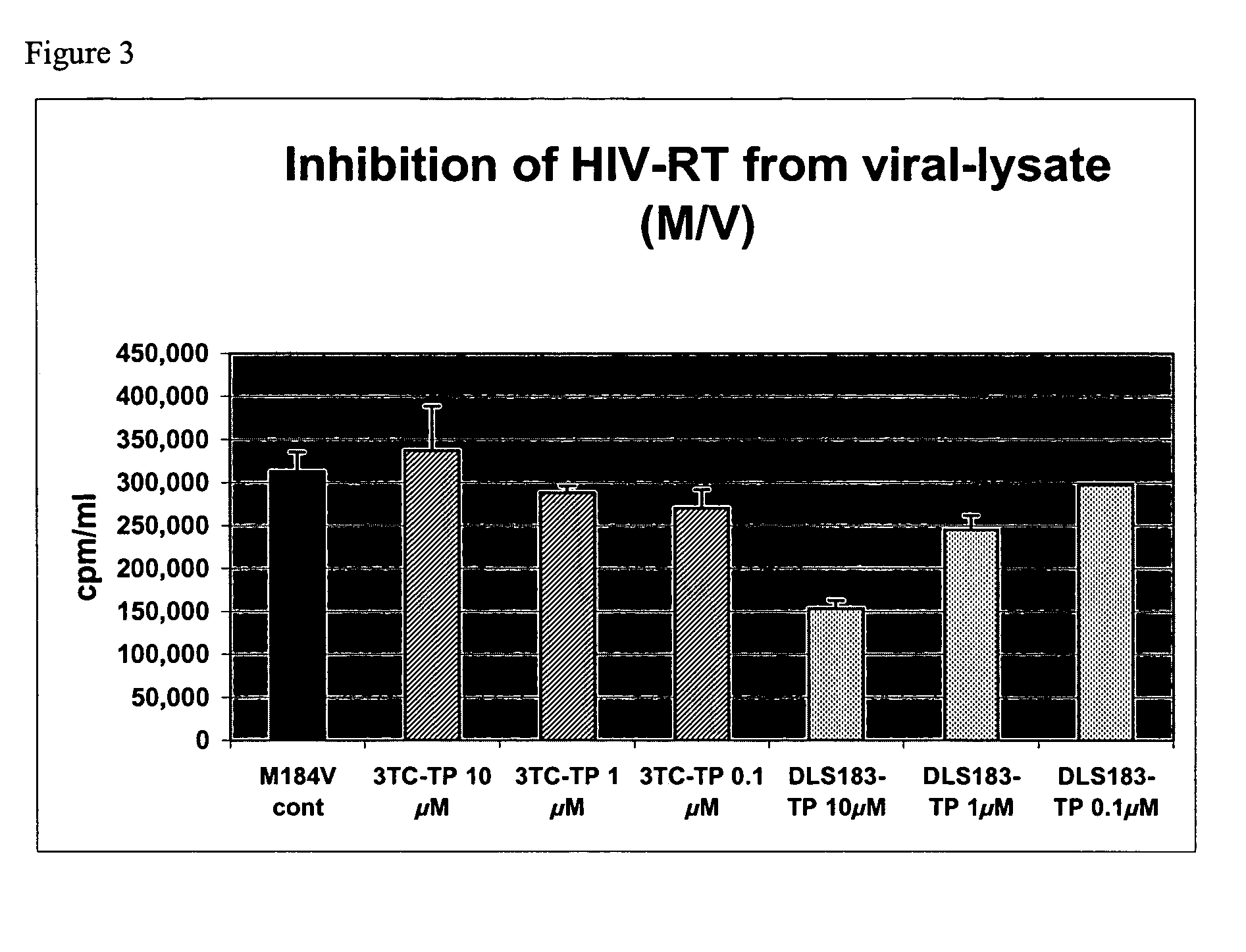2' and 3'-substituted cyclobutyl nucleoside analogs for the treatment of viral infections and abnormal cellular proliferation
a technology of cyclobutyl nucleosides and cyclobutyl nucleosides, which is applied in the direction of biocide, group 5/15 element organic compounds, drug compositions, etc., can solve the problems of fulminant hepatitis, jaundice, and increased blood levels of certain enzymes, and the emergence of mutated variants of human immunodeficiency virus type 1 (hiv-1) resistant to antiviral drugs
- Summary
- Abstract
- Description
- Claims
- Application Information
AI Technical Summary
Benefits of technology
Problems solved by technology
Method used
Image
Examples
example 1
trans-3-(Benzyloxymethyl)cyclobutanol
[0291]
[0292]trans-3-(Benzyloxymethyl)cyclobutanol was prepared according to published procedure of Reese, C. B. et. al. J. Chem. Soc., PT1 1998, 2827.
[0293]A solution of DIAD (2.15 g, 10.6 mmol) in anhydrous THF (10 mL) was added dropwise to a mixture of trans-3-(benzyloxymethyl)cyclobutanol (0.85 g, 4.4 mmol), 3-benzoyl-5-fluorouracil (1.55 g, 6.6 mmol), and triphenylphosphine (2.9 g, 11.07 mmol) in THF (35 mL) at 0° C. The mixture was aged for 72 h at ambient temperature and then concentrated by rotary evaporator. The resulting gum was purified by chromatography over silica gel with a gradient from 10% to 25% EtOAc in hexanes. Fractions with product still contained DIAD and PPh3 as impurities. Isolated 3-benzoyl-5-fluoro-1-[cis-3-(benzyloxymethyl)cyclobutyl]uracil (1.5 g) as impure mixture and used in next step without further purification.
[0294]A solution of 3-benzoyl-5-fluoro-1-[cis-3-(benzyloxymethyl)cyclobutyl]uracil (1.5 g) in ethanol (100...
example 2
trans-3-(Benzyloxymethyl)cyclobutanol triphosphate
[0297]
[0298]A solution of 5-fluoro-1-[cis-3-(hydroxymethyl)cyclobutyl]cytosine (23 mg, 0.11 mmol) in triethylphosphate was cooled to 0° C. and treated dropwise with phosphorus oxychloride. The mixture was aged for 20 h at 0° C. and then treated with water (0.1 mL). The mixture was aged for 6 h and then concentrated under high vacuum. The crude gum was purified by chromatography on SP207 resin with a gradient from 0-20% methanol in water. Fractions were analyzed by HPLC (reverse phase) and appropriate fractions were lyophilized to give 5-fluoro-1-[cis-3-(hydroxymethyl)cyclobutyl]cytosine mono-phosphate (30 mg) as a gum and was used in next step without further purification. A suspension of 5-fluoro-1-[cis-3-(hydroxymethyl)cyclobutyl]cytosine monophosphate (30 mg) in tert-butanol (1 mL) and water (1 mL) was heated under a gentle reflux while a solution of DCC (91 mg, 0.44 mmol) in tert-butanol was added dropwise over a 1 h period. Afte...
example 3
3-(Benzyloxymethyl)-2,2-dichlorocyclobutanone
[0299]Trichloroacetyl chloride (108 ml, 0.96 mol) was added slowly to a stirred suspension of freshly activated zinc-copper couple (56 g), allyl benzyl ether (50 ml, 0.32 mol), dry 1,2-dimethoxyethane (95 ml) and dry diethyl ether (550 ml) in a 2 L three-neck flask under argon. The reactants were heated under gentle reflux for 3d. The products were then filtered and the residue was washed with ether. The combined filtrate and washings were concentrated under reduced pressure. Light petroleum ether was added and the mixture was stirred vigorously. The supernatant was decanted and more light petroleum ether was added. After vigorous stirring the supernatant was again decanted and mixed with the original supernatant. The resulting solution was washed with saturated NaHCO3 twice and brine once. The organic phase was dried over MgSO4 and the solvent was evaporated to give a light yellow oil which was used directly in the next step. 1H NMR (CDC...
PUM
| Property | Measurement | Unit |
|---|---|---|
| time | aaaaa | aaaaa |
| time | aaaaa | aaaaa |
| path length | aaaaa | aaaaa |
Abstract
Description
Claims
Application Information
 Login to View More
Login to View More - R&D
- Intellectual Property
- Life Sciences
- Materials
- Tech Scout
- Unparalleled Data Quality
- Higher Quality Content
- 60% Fewer Hallucinations
Browse by: Latest US Patents, China's latest patents, Technical Efficacy Thesaurus, Application Domain, Technology Topic, Popular Technical Reports.
© 2025 PatSnap. All rights reserved.Legal|Privacy policy|Modern Slavery Act Transparency Statement|Sitemap|About US| Contact US: help@patsnap.com



